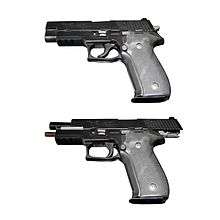Pistol slide

The slide is the part on a majority of semi-automatic pistols that moves during the operating cycle and generally houses the firing pin/striker and the extractor, and serves as the bolt. It is spring-loaded so that once it has moved to its rearmost position in the firing cycle, spring tension brings it back to the starting position chambering a fresh cartridge during the motion provided that the magazine is not empty.
Through the principles of recoil or blowback operation, the slide is forced back with each shot. Generally, this action serves three purposes: ejecting the spent casing, cocking the hammer or striker for the next shot, and loading another cartridge into the chamber when the slide comes forward.
On most designs, once the magazine and chamber both are empty, the slide will lock back, released only when the slide stop is depressed; if a new magazine is inserted before the slide stop is depressed then a new cartridge will be chambered.
Automatically cocking the hammer or striker is an important function of double-action / single-action pistols. However, some semi-auto pistols are double-action only, and have no sear notch for single-action operation.
See also
- John Browning
- FN M1900 first pistol to use a slide